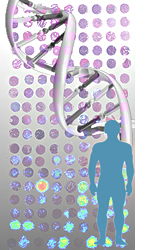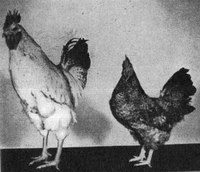The genotype of an organism is its complete set of genetic material. Genotype can also be used to refer to the alleles or variants an individual carries in a particular gene or genetic location. The number of alleles an individual can have in a specific gene depends on the number of copies of each chromosome found in that species, also referred to as ploidy. In diploid species like humans, two full sets of chromosomes are present, meaning each individual has two alleles for any given gene. If both alleles are the same, the genotype is referred to as homozygous. If the alleles are different, the genotype is referred to as heterozygous.

Lovebird is the common name for the genus Agapornis, a small group of parrots in the Old World parrot family Psittaculidae. Of the nine species in the genus, all are native to the African continent, with the grey-headed lovebird being native to the African island of Madagascar.

In genetics, dominance is the phenomenon of one variant (allele) of a gene on a chromosome masking or overriding the effect of a different variant of the same gene on the other copy of the chromosome. The first variant is termed dominant and the second is called recessive. This state of having two different variants of the same gene on each chromosome is originally caused by a mutation in one of the genes, either new or inherited. The terms autosomal dominant or autosomal recessive are used to describe gene variants on non-sex chromosomes (autosomes) and their associated traits, while those on sex chromosomes (allosomes) are termed X-linked dominant, X-linked recessive or Y-linked; these have an inheritance and presentation pattern that depends on the sex of both the parent and the child. Since there is only one copy of the Y chromosome, Y-linked traits cannot be dominant or recessive. Additionally, there are other forms of dominance, such as incomplete dominance, in which a gene variant has a partial effect compared to when it is present on both chromosomes, and co-dominance, in which different variants on each chromosome both show their associated traits.

Equine coat color genetics determine a horse's coat color. Many colors are possible, but all variations are produced by changes in only a few genes.

Sex linked describes the sex-specific reading patterns of inheritance and presentation when a gene mutation (allele) is present on a sex chromosome (allosome) rather than a non-sex chromosome (autosome). In humans, these are termed X-linked recessive, X-linked dominant and Y-linked. The inheritance and presentation of all three differ depending on the sex of both the parent and the child. This makes them characteristically different from autosomal dominance and recessiveness.

Non-Mendelian inheritance is any pattern in which traits do not segregate in accordance with Mendel's laws. These laws describe the inheritance of traits linked to single genes on chromosomes in the nucleus. In Mendelian inheritance, each parent contributes one of two possible alleles for a trait. If the genotypes of both parents in a genetic cross are known, Mendel's laws can be used to determine the distribution of phenotypes expected for the population of offspring. There are several situations in which the proportions of phenotypes observed in the progeny do not match the predicted values.

Human genetics is the study of inheritance as it occurs in human beings. Human genetics encompasses a variety of overlapping fields including: classical genetics, cytogenetics, molecular genetics, biochemical genetics, genomics, population genetics, developmental genetics, clinical genetics, and genetic counseling.
In genetics, a reciprocal cross is a breeding experiment designed to test the role of parental sex on a given inheritance pattern. All parent organisms must be true breeding to properly carry out such an experiment. In one cross, a male expressing the trait of interest will be crossed with a female not expressing the trait. In the other, a female expressing the trait of interest will be crossed with a male not expressing the trait. It is the cross that could be made either way or independent of the sex of the parents. For example, suppose a biologist wished to identify whether a hypothetical allele Z, a variant of some gene A, is on the male or female sex chromosome. They might first cross a Z-trait female with an A-trait male and observe the offspring. Next, they would cross an A-trait female with a Z-trait male and observe the offspring. Via principles of dominant and recessive alleles, they could then make an inference as to which sex chromosome contains the gene Z, if either in fact did.

The rosy-faced lovebird, also known as the rosy-collared or peach-faced lovebird, is a species of lovebird native to arid regions in southwestern Africa such as the Namib Desert. Loud and constant chirpers, these birds are very social animals and often congregate in small groups in the wild. They eat throughout the day and take frequent baths. Coloration can vary widely among populations. Plumage is identical in males and females. Lovebirds are renowned for their sleep position in which they sit side-by-side and turn their faces in towards each other. Also, females are well noted to tear raw materials into long strips, "twisty-tie" them onto their backs, and fly substantial distances back to make a nest. These birds are common in the pet industry.

X-linked dominant inheritance, sometimes referred to as X-linked dominance, is a mode of genetic inheritance by which a dominant gene is carried on the X chromosome. As an inheritance pattern, it is less common than the X-linked recessive type. In medicine, X-linked dominant inheritance indicates that a gene responsible for a genetic disorder is located on the X chromosome, and only one copy of the allele is sufficient to cause the disorder when inherited from a parent who has the disorder. In this case, someone who expresses an X-linked dominant allele will exhibit the disorder and be considered affected.

A sex chromosome is a chromosome that differs from an ordinary autosome in form, size, and behavior. The human sex chromosomes, a typical pair of mammal allosomes, carry the genes that determine the sex of an individual created in sexual reproduction. Autosomes differ from allosomes because autosomes appear in pairs whose members have the same form but differ from other pairs in a diploid cell, whereas members of an allosome pair may differ from one another and thereby determine sex.
Pseudodominance is the situation in which the inheritance of a recessive trait mimics a dominant pattern.

A hereditary carrier, is a person or other organism that has inherited a recessive allele for a genetic trait or mutation but usually does not display that trait or show symptoms of the disease. Carriers are, however, able to pass the allele onto their offspring, who may then express the genetic trait.

The science of cockatiel colour genetics deals with the heredity of colour variation in the feathers of cockatiels, Nymphicus hollandicus. Colour mutations are a natural but very rare phenomenon that occur in either captivity or the wild. About fifteen primary colour mutations have been established in the species which enable the production of many different combinations. Note that this article is heavily based on the captive or companion cockatiel rather than the wild cockatiel species.
The Cinnamon Budgerigar Mutation is one of approximately 30 mutations affecting the colour of budgerigars. It is the underlying mutation of the Cinnamon variety and, with Ino, a constituent mutation of the Lacewing variety.
The Ino budgerigar mutation is one of approximately 30 mutations affecting the colour of budgerigars. It is the underlying mutation of the Albino and Lutino varieties and, with Cinnamon, a constituent mutation of the Lacewing variety.
The Sex-linked (SL) Clearbody budgerigar mutation is one of approximately 30 mutations affecting the colour of budgerigars. It is the underlying mutation of the Texas Clearbody variety.

Zygosity is the degree to which both copies of a chromosome or gene have the same genetic sequence. In other words, it is the degree of similarity of the alleles in an organism.

The lutino peach-faced love bird is one of the most popular mutations of rosy-faced lovebird. It is closely followed by the Dutch blue lovebird in popularity.

Dwarfism in chickens is an inherited condition found in chickens consisting of a significant delayed growth, resulting in adult individuals with a distinctive small size in comparison with normal specimens of the same breed or population.

















